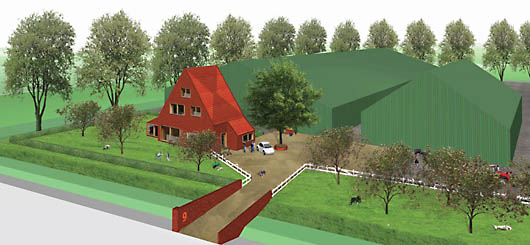|
|
P | dd | wat
maakt een boerderij? (what makes a Farm?) 2nd PRIZE competition "Een boerderijenfamilie voor de Overdiepse Polder" Location: Overdiepse polder (NL) Team: Erno Langenberg, Joris Hekkenberg (Hekkenbergarchitects) Year: 2010 Tags: Architecture,Overdieps, Flexible, Ruimte voor de rivier, Province Noord-Brabant |
d |
| 5 | ||||
| Ideas for a family of farms for the
“Overdiepse Polder” “Wat maakt een boerderij?” (what makes a farm?) is a proposal for the closed competition “Een boerderijenfamilie voor de Overdiepse Polder: eenheid in verscheidenheid” organized by the Province of Brabant. Once every 25 years the Overdiepse Polder is expected to flood. This prediction is based on a state strategy that defines 'controlled flooding areas' to prevent unexpected flooding in other more-densely populated areas. To be able to use this land as agriculture land the Province of Brabant will create nine mounds risen above the water level. Here the Province plans to built fully operational farms: the “Overdiepse farms”. In a normal scenario these farms will simply stand on hills, when the sporadic flooding occurs this platforms become isolated farm-islands. The goal of this competition was to find a language that connects the nine farms taking into consideration the possible change of landscape.  Overview of the farm on the mound
Our
proposals for an
architecturally cohesive 'family of farms' focuses on the residential
section of the farms, the business area of the farm as well as the
mount were a given.  The house is located
toward the entrance, creating a square
 Relation between the farm house and the location on the plot   Set of attributes for the farm
house Set of attributes for the farm
house-On each of the farms access entrance leads to a centralizing point, a court yard. -From the courtyard all the farm function divert: housing, business, storage, etc. -A solitary tree is placed on the entrance court and marks the transition between the private section of the farm and the business section, also protecting the house from the large farm equipment. -The farmhouse is placed on the existing tapering lots, parallel to a local dike. -The direction of the farmhouse roof is placed parallel to the stable's roof, giving the farm a 'face' to the street and a distinctive silhouette -Windows are placed in the wide street facade, no windows are placed on the roof. -The prominent pitched-roof without openings remain as a recognizable whole. -The pitch-roof is a 'double height hood' that emphasizes the 'farm feel'. -Seen from afar one recognizes the same clusters of buildings over the diverse mounts which reinforces the idea that one is looking at a family of farms.    Section of the mound showing the
symbiosis between the farm and stable
 |
||||
